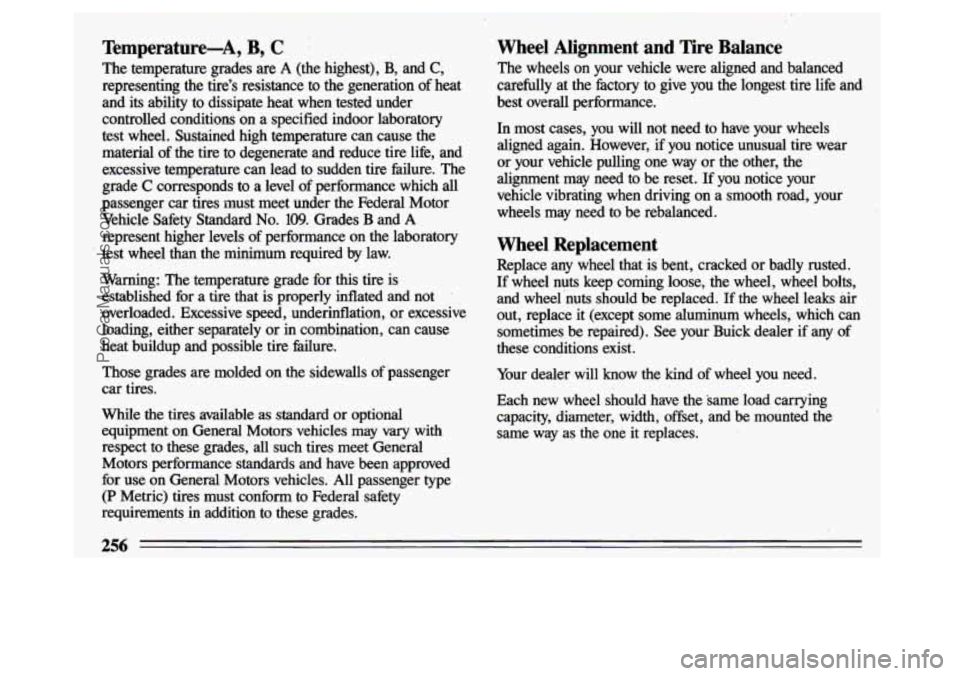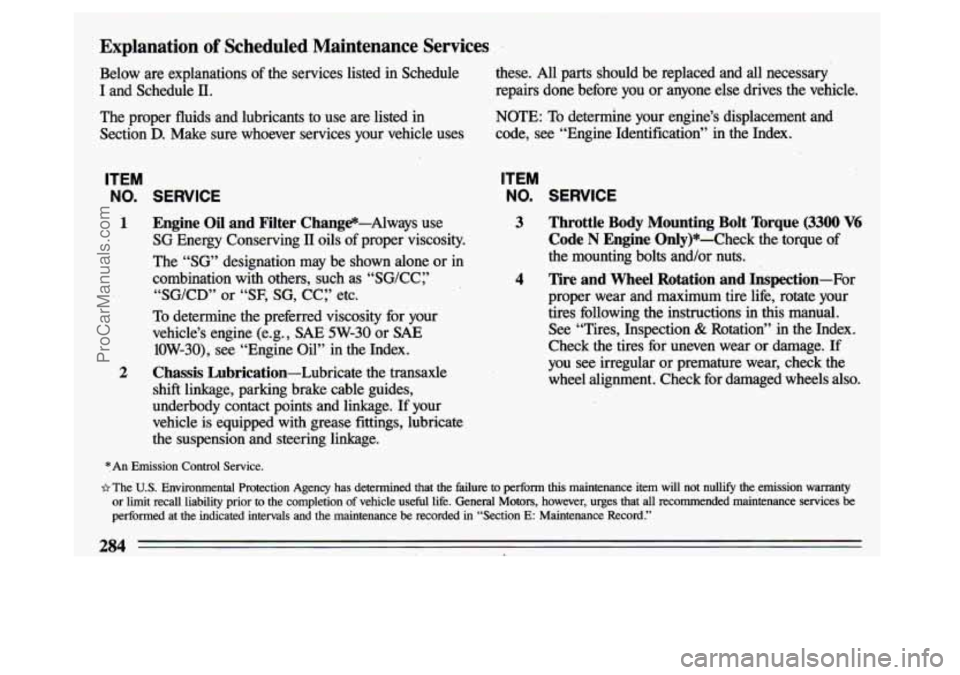Page 215 of 324
I A CAUTION:
Rust or dirt on the wheel, or on the parts to
which
it is fastened, can make the wheel nuts
become loose after a time. The wheel could
come
off and cause an accident. When you
change a wheel, remove any rust or
dirt from
the places where the wheel attaches to the
vehicle. In an emergency, you can use
a cloth
or a paper towel to do this; but be sure
to use
a scraper or wire brush later, if you need to, to
get all the rust or
dirt off. ’. : .a.
I
5. Remove any rust or dirt from the wheel bolts,
mounting surfaces
or spare wheel.
6. Place the spare on the
wheel mounting surface.
ProCarManuals.com
Page 258 of 324

Temperature-A, B, C
The temperature grades are A (the highest), B, and C,
representing the tire's resistance to the generation of heat
and
its ability to dissipate heat when tested under
controlled conditions on a specified indoor laboratory
test wheel. Sustained high temperature can cause the material'of the tire to degenerate and reduce tire life, and
excessive temperature can lead to sudden tire failure. The
grade
C corresponds to a level of performance which all
passenger car tires must meet under the Federal Motor
Vehicle Safety Standard
No. 109. Grades B and A
represent higher levels of performance on the laboratory
test wheel than the minimum required by law.
Warning: The temperature grade for
this tire is
established for a tire that is properly inflated and
not
overloaded. Excessive speed, underinflation, or excessive
loading, either separately or in combination, can cause
heat buildup and possible tire failure.
Those grades are molded on the sidewalls of'passenger
car tires.
While the tires available as standard or optional
equipment on General Motors vehicIes may vary with
respect to these grades, all such tires meet General
Motors performance standards and have been approved
for use
on General Motors vehicles. All passenger type
(P Metric) tires must conform to Federal safety
requirements in addition to these grades.
Wheel Alignment and Tire Balance
The wheels on your vehicle were aligned and balanced
carefully at the, factory to give you the longest tire life and
best overall performance.
In most cases, you will not need to have your wheels
aligned again. However, if you-notice unusual tire wear
or your vehicle pulling one way or the other, the
alignment may need
to be reset. If you notice your
vehicle vibrating when driving on a
smooth road, your
wheels may need to be rebalanced.
Wheel Replacement
Replace any wheel that is bent, cracked or badly rusted.
If wheel nuts keep coming loose, the wheel, wheel bolts,
and wheel'nuts should be replaced. If the wheel leaks air
out, replace it (except some aluminum wheels, which can sometimes be repaired). See your Buick dealer
if any of
these conditions exist.
Your dealer will know the kind
of wheel you need.
Each new wheel should have the same load carrying
capacity, diameter, width, offset, and be mounted the same way as the one
it replaces.
256
ProCarManuals.com
Page 259 of 324
If you need to replace any of your wheels., wheel bolts, or
wheel nuts, replace them only with new
GM original
equipment parts. This way, you will be sure
you have the
right wheel, wheel bolts, and wheel nuts for your Buick
model.
A CAUTION:
Using the wrong replacement wheels, wheel
bolts, or wheel nuts on your vehicle can be
dangerous.
It could affecf the braking and
handling of your vehicle, make your tires lose
air and make you lose control. You could have
a collision in which you or others could be
injured. Always use the correct wheel, wheel
bolts,
and wheel nuts for replacement.
Used Replacement Wheels
Tire Chains
257
ProCarManuals.com
Page 286 of 324

Explanation of Scheduled Maintenance Services
Below are explanations of the services listed in Schedule
I and Schedule II.
The proper fluids and lubricants to use are listed in
Section
D. Make sure whoever services your vehicle uses
ITEM
NO. SERVICE
1 Engine Oil and Filter Change-Always use
SG Energy Conserving 11 oils of proper viscosity.
The “SG” designation may be shown alone or in
combination with others, such as ‘‘SG/CC:’
“SG/CD” or “SF, SG, CC:’ etc.
To determine the preferred viscosity for your
vehicle’s engine (e.g., SAE
5W-30 or SAE
10W-30), see “Engine Oil” in the Index.
2 Chassis Lubrication-Lubricate the transaxle
shift linkage, parking brake cable guides,
underbody contact points and linkage. If your
vehicle is equipped with grease fittings, lubricate
the suspension and steering linkage. these. All parts should be replaced and all necessary
repairs done before you or anyone else drives the vehicle.
NOTE: To determine your engine’s displacement and
code, see “Engine Identification” in the Index.
ITEM
NO. SERVICE
3 Throttle Body Mounting Bolt Torque (3300 V6
Code N Engine Only)*-Check the,torque of
the mounting bolts and/or nuts.
4 Tire and Wheel Rotation and Inspection-For
proper wear and maximum tire life, rotate your
tires following the instructions
in this manual.
See “Tires, Inspection & Rotation” in the Index.
Check the tires for uneven wear or damage. If
you see irregular or premature wear, check the
wheel alignment. Check for damaged wheels also.’
*An Emission Control Service.
~2 The U.S. Environmental Protection Agency has determined that the failure to perform this maintenance item will not nullify the.emission warranty
or limit recall liability prior
to the completion of vehicle useful life. General Motors, however, urges that all recommended maintenance services be
performed at the indicated intervals and the maintenance be recorded in “Section E: Maintenance Record.”
284
ProCarManuals.com